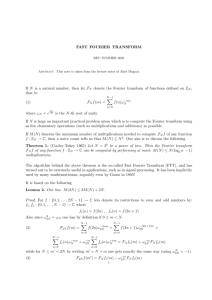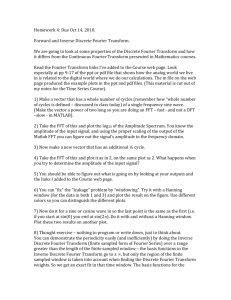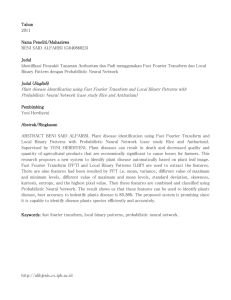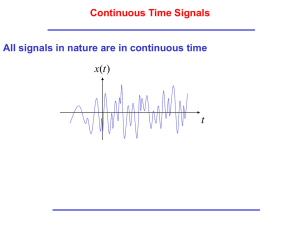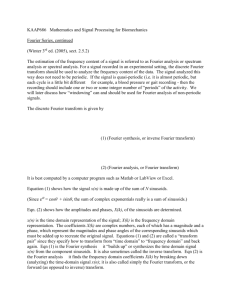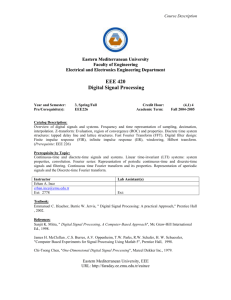3 THE FAST FOURIER
advertisement
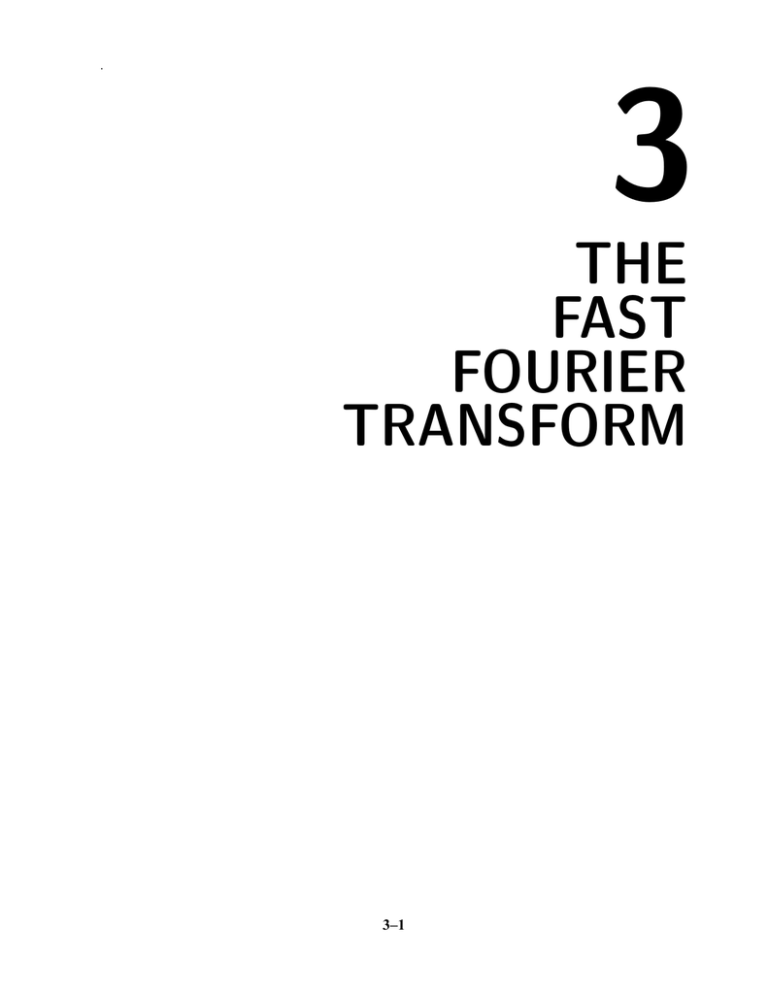
3
.
THE
FAST
FOURIER
TRANSFORM
3–1
Chapter 3: THE FAST FOURIER TRANSFORM
3–2
§3.1 FFT IN A NUTSHELL
Even though this course is not about any numerical recipe, in order for us to utilize the numerical
tools in intelligent ways, it pays to understand the essnetial features of the tools we would frequently
use. the Fast Fourier Transform (FFT) is one such numerical tool. According to G. Strang, FFT is
perhaps the most widely used numerical tool today in scientific and engineering computations. To
c version the Fourier transform:
start our discussion of FFT, let us recall MATLAB
X (k) =
N −1
x(s)e− j2πkn/N
, k = 0, 1, . . . , N − 1
(3.1)
n=0
where the denominator 1/N is omitted for brevity.
The one thing we have taken for granted is that for every kthe Fourier coefficient term, X (k), one
must perform N-complex term multiplications and N additions, thus requiring N 2 multiplications
in order to obtain the complete coefficients. Hence, for a measurement data set of 100 with 1,024
sample points, one would need approximately a total of 108 complex-function multiplications just to
obtain the Fourier coefficients, not to mention the inverse Fourier transform. Now, if the fundamental
frequency is about 1 Hz and one wishes to capture up to 1 KHz frequency components, then the
minimum number of samples would be about 4,096. This then would require about 1.6 × 109
operations. An FFT algorithm would reduce the multiplications by a factor of 6N :
N2
224
≈ 682!
=
6N
6 × 212
(3.2)
To appreciate the tremendous computational efficiency improvements possible by FFT, let us consider the case of N = 4 (4 samples per period, a very crude sampling!) and introduce the following
notation
w = e− j2π/N , or
w = e− jπ/2 for N = 4
(3.3)
Hence, the four equations from (3.1) can be written as
n=0:
n=1:
n=2:
n=3:
X (0) = x((0)w0 + x((1)w0 + x((2)w0 + x((3)w0
0
1
2
3
X (1) = x((0)w + x((1)w + x((2)w + x((3)w
X (2) = x((0)w0 + x((1)w2 + x((2)w4 + x((3)w6
0
3
6
9
X (3) = x((0)w + x((1)w + x((2)w + x((3)w
which can be written in matrix form as
3–2
(3.4)
3–3
§3.1
FFT IN A NUTSHELL
{X4 } = F4 {x4 }
X4 = [ X (0)
x4 = [ x(0)
0
w
w0
F4 = 0
w
w0
X (1)
X (2)
X (3) ]T
x(1) x(2) x(3) ]T
w0 w0 w0
w1 w2 w3
w2 w4 w6
w3 w6 w9
(3.5)
Note from (3.3) we have
w6 = w2
w0 = 1
e− jπ/2
since
and
6
2 = e− jπ = e− jπ/2
w4 = w0
so that F4 is simplified to:
1 1
1 w1
F4 =
1 w2
1 w3
1
w2
1
w2
1
w3
w2
w1
(3.6)
Observe from the above equation that the computation of X (k) will require N 2 complex multiplications and N (N − 1) complex additions. Hence, for a large N , computations can become quickly
prohibitive. (Remember FFT is often used in conjunction with real-time identification problems!)
The key in reducing the computational overhead drastically is the following product form of F4 :
1 0
0 1
F4 =
1 0
0 1
1
0
−1
0
0
1 w0
w1 1 w2
0
0 0
1
0 0
−w
0
0
1
w0
0
1
0 0
w0
0
2
w
0
0
0
1
0
0
1
0
0
0
0
0
1
(3.7)
Notice that the third matrix in the above equation is just a permutation operator; the even-numbered
samples are stacked first in the vector x4 , which is followed by the odd-numbered vectors. Specifically, we have
x(0)
1
x(2) 0
=
x(1)
0
x(3)
0
0
0
1
0
0
1
0
0
Thus, the following pattern emerges from this equation
3–3
0
x(0)
0 x(1)
0
x(2)
1
x(3)
3–4
Chapter 3: THE FAST FOURIER TRANSFORM
I
F4 = 2
I2
W2
−W2
1
W2 =
0
0
w1
0
F2
F2
0
even/odd permutation
operator
(3.8)
w0
w2
1
F2 =
w0
It is the generality of the preceding product-form decomposition that renders FFT an efficient tool.
For example, for N = 512, we have the following product form:
F512
I
= 256
I256
W256
−W256
0
F256
F256
0
even/odd permutation
operator
(3.9)
W256 = diag(w0 , w1 , . . . , w255 )
The successive inversions of the first product matrix is trivial since W is diagonal:
I256
I256
W256
−W256
−1
=
1
2
I256
W∗256
I256
−W∗256
where W∗ is the complex conjugate of W.
The key aspect of the FFT algorithm is in the successive decomposition of F512 into:
3–4
(3.10)
3–5
§3.1
F256
I
= 128
I128
W128
−W128
F128
0
0
F128
FFT IN A NUTSHELL
even/odd permutation
operator
W128 = diag(w0 , w1 , . . . , w128 )
F128
I
= 64
I64
W64
−W64
0
F64
F64
0
even/odd permutation
operator
W64 = diag(w0 , w1 , . . . , w64 )
F64
I
= 32
I32
W32
−W32
F32
0
0
F32
even/odd permutation
operator
(3.11)
W64 = diag(w0 , w1 , . . . , w32 )
...
...
I2 W2
F2 0
even/odd permutation
F4 =
I2 −W2
operator
0 F2
W = diag(w0 , w1 )
The result of the FFT algorithm outlined above reduces the discrete Fourier transform from O(N 2 )
to O( 12 N log2 N ) algorithm, a marvelous achievement by numerical analysts during the 1960s.
It turns out that there is a competitive transform that works exclusively from time-domain signals
to time-domain expansion coefficients. This is called wavelet transform,
which we will study later
√
in the course. Observe that each column in F N , if normalized by N , constitutes an orthonormal
vector. However, each basis function cos 2πkt in the Fourier series expansion is non-compact. The
wavelet basis functions are, on the other hand, compact. Thus, a race has begun between FFT and
FWT (Fast Wavelet Transform).
References for FFT
1.
G-AE Subcommittee on Measurement Concepts. “What is the Fast Fourier Transform?” IEEE
Trans. Audio and Electroacustics. (June 1967), Vol. AU-15, pp. 45-55. Also Proc. IEEE
(Oct. 1967), Vol. 55, pp. 1664-1674.
2.
Bergland, G.D. “A Guided Tour of the Fast Fourier Transform.” IEEE Spectrum (1969), Vol.
6, No.7, pp. 41-52.
3.
Brigham, E.O., The Faster Fourier Transform and Its Applications, Prentice-Hall, 1988.
4.
Brigham, E. O., and R. E. Morrow. “The Fast Fourier Transform.” IEEE Spectrum (December
1967), Vol. 4, pp. 63-70.
3–5
Chapter 3: THE FAST FOURIER TRANSFORM
3–6
5.
Cooley, J. W., and J. W. Tukey. “An Algorithm for Machine Calculation of Complex Fourier
Series.” Math Computation (April 1965), Vol. 19, pp. 297-301.
6.
Cooley, J. W., P. A. W. Lewis, and P. D. Welch. “The Finite Fourier Transform.”IEEE Trans.
on Audio and Electroacoustics (June 1969), Vol. AU17, No. 2, pp. 77-85.
7.
Cooley, J. W., P. A. W. Lewis, and P. D. Welch. “The Fast Fourier Transform and its Applications.” IEEE Trans on Education (March 1969), Vol. 12, pp. 27-34.
8.
Cooley, J. W., P. A. W. Lewis, and P. D. Welch. “The Fast Fourier Transform Algorithm:
Programming Consideration in the Calculation of Sine, Cosine and Laplace Transforms.” J.
Sound Vib. (July 1970), Vol. 12, No. 3, pp. 315-337.
9.
Durvasula, S., B. Panda, and R. K. Kapania, “Impulse Excitation Technique For Determining
Vibration Characteristics Of Aeroelastic Models of Tall Structures,”Inst Eng India Part ND 2,
Vol. 61, May 1981.
10. Eshleman, R. L., “Machinery Diagnostics And Your FFT,” S. V. Sound and Vibration, Vol. 17,
No. 4, pp. 12-18, April 1983.
11. Gentleman, W.M., and G. Sande. “Fast Fourier Transform for Fun and Profit,” AFIPS Proc.,
1966 Fall Joint Computer Conf., Vol. 29, pp. 563-678, Washington, DC: Spartan, 1966.
12. Halliwell, G., “Using Fourier Transform Analysers To Investigate Component Vibration,”
Nuclear Engineering International (GB), Vol. 25, 296, pp. 42-45, March 1980.
13. Harris, F. J. “On the Use of Windows for Harmonics Analysis with the Discrete Fourier
Transform.” Proc. IEEE (January 1978), Vol. 66, No. 1, PP. 51-83.
14. Karlsson, L., “Numerical Analysis of Damped Transient Beam Vibration by Use of Fourier
Transforms,” Int. J. Numer. Methods Eng. (GB), Vol. 21, No. 4, pp. 683-89, April 1985.
15. Parmenter, W. W., and R. G. Christiansen, “Recovery of Modal information Form a Beam
Undergoing Random Vibration,” Trans. ASME Ser. B., Vol. 96, No. 4, pp. 1307-13,
November 1974.
16. Radcliffe, C. J., and C. D. Mote, Jr., “Identification and Control of Rotating Disk Vibration,”
Trans ASME J. Dyn. Syst. Meas. and Control, Vol. 105, No. 1, pp. 39-45, March 1983.
17. Ramirez, R. W. The FFT Fundamentals and Concepts. Englewood Cliffs, NJ: Prentice-Hall,
1985.
18. Taylor, T. D., R. S. Hirsh, and M. M. Nadworny, “Comparison of FFT, Direct Inversion and
Conjugate Gradient Methods For Use in Pseudo-Spectral Methods,” Computers & Fluids, Vol.
12, No. 1, pp. 1-9, 1984.
3–6
3–7
§3.1
FFT IN A NUTSHELL
19. Webb, R., “Frequency Somain Instrumentation Techiniques For The Condition Monitoring of
Rotating Machinery,” Noise and Vib. Control Worldwide (GB), Vol. 14, No. 8, pp. 215-19,
October 1983.
3–7

